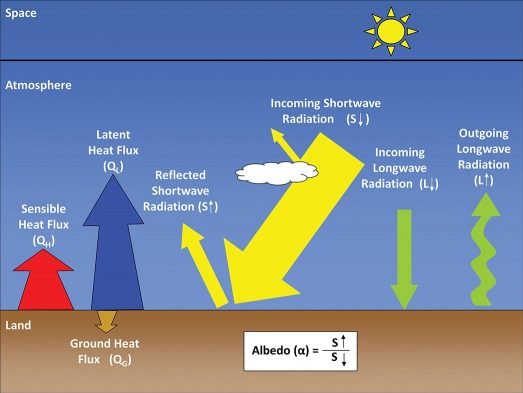The ‘cool’ crop
The canola flower is more than just a pretty sight – it’s highly reflective! A flowering canola crop creates a bright yellow canopy covering approximately 20 million acres in Western Canada. This canopy, which reflects solar radiation away from the Earth, has the potential to provide a significant cooling effect.
“A few years ago, as part of a World Meteorological Organization sponsored workshop on the contribution of agriculture to the state of climate, we examined the reflectance of different types of vegetation and reported a large positive impact from agricultural crops as compared to native vegetation in cooling the atmosphere,” explains Ray Desjardins, atmospheric scientist with Agriculture and Agri-Food Canada (AAFC) in Ottawa. “More recently we have been measuring the fraction of solar radiation reflected by various crops in Canada to try to better understand their potential contribution to mitigate climate change.”
A small change in reflected solar radiation can change the temperature on a global scale. Desjardins explains, as a general rule, an increase in the reflected radiation by one Watt/m2 on a global scale can decrease the temperature at the earth surface by 0.5°C.
To measure the amount of reflected shortwave radiation at the field scale, researchers use upward and downward looking pyranometers mounted on either a tower or airplane. Satellite-based sensors, such as Moderate Resolution Imaging Spectrometer (MODIS), show vegetative growth and can also be used to estimate the fraction of solar radiation reflected by crops growing anywhere in Canada. Sensors used to measure all the shortwave radiation between 0.3 and 2.8 microns, compared to the eye that sees only 0.4 to 0.7 microns.
“The fraction of shortwave radiation reflected by a crop is also called the albedo, which is a non-dimensional quantity that indicates how well a surface reflects the sun’s shortwave radiation,” says Desjardins. “Albedo varies between zero for black and one for white, with fresh snow having an albedo of approximately 0.9, while grasslands are 0.3 or lower. For field crops, reflectance measurements for the whole growing season showed that after the ground is covered by vegetation, the albedo values average 0.217 for soybean, 0.221 for corn, 0.202 for spring wheat and 0.247 for canola (or around 25 per cent reflectivity).”
Land use change, management practices such as no-till and crops can create cooling, not just through reflectivity and carbon sequestration, but also through transpiration which results in more cloud formation and more shortwave radiation reflected,” adds Desjardins. “Although we have not yet completed our analysis, overall canola has a higher albedo than most other crops, which adds up to a cooling of about 0.5°C during the growing season as compared to a crop like wheat.” Published results are expected to be available in summer 2019.

Credit: Science and Technology Branch, Agriculture and Agri-Food Canada.





